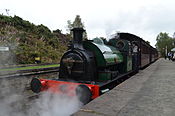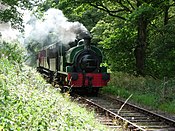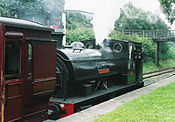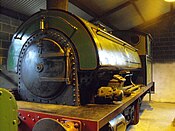Tanfield Railway
| Tanfield Railway | |
|
County Durham | |
|---|---|
 An overview of the railway from Furnace Sidings | |
| Gauge: | 4 ft 8.5" |
| Location: | 54°54’29"N, 1°40’30"W |
| No. of stations: | 4 |
| Track: | 3 miles |
| Information | |
| Website: | tanfield-railway.co.uk |
The Tanfield Railway is a standard gauge heritage railway with a three-mile track in the north of County Durham. It runs on part of a former colliery wooden wagonway, later a steam railway
The railway today operates preserved industrial diesel and steam tank locomotives. The railway operates a passenger service on Sundays all year round, as well as demonstration freight trains. The line runs three miles between a southern terminus at East Tanfield, to a northern terminus at Sunniside near Gateshead, with the main station, Andrews House situated near to the Marley Hill engine shed. A halt also serves the historic site of the Causey Arch. The railway claims to be the oldest working railway in the world.
Colliery Railway
The Tanfield Railway was originally built to transport coal from the collieries of County Durham, to the staithes on the River Tyne, for onward transport in colliers (bulk coal carrying ships).[1] The oldest part of the original Tanfield Railway, located to the north east of the present heritage line, in the Lobley Hill area, dated from 1647, and was in continuous use until final closure in 1964.[1]
The route and structures of the oldest section of the now preserved part of the line, between Sunniside and Causey, dates from 1725, and is thus claimed to be the World's oldest working railway.[1][2] The Middleton Railway too claims to be the oldest working railway, on the basis that it was the first railway granted powers under the first railway Act of Parliament in 1758.[2] The Causey to East Tanfield section was built in 1839.[1]
The Marley Hill engine shed was built in 1854, and in use until 1970.[1] The shed first housed a winding engine before the arrival of locomotives.[3] The shed was originally on the Bowes Railway, with locomotices used on the Tanfield branch stabled at the nearby Bowes Bridge MPD (a sub-shed of Gateshead) whose coaling stage and turntable pit are still visible adjacent to the track between Andrews House and Sunniside. The headshunt by the signal box is the point where the Bowes Railway crossed the Tanfield branch. When the line was re-opened a curve was installed to allow trains access to the shed. It is thought to be the oldest engine shed in the world still used for its original function.[4] Although the line to the shed closed in 1962, it remained in use servicing other colliery railway's locomotives in the area.[4]
Originally a wooden railed horse drawn wagonway, conversion to a conventional steel railed railway began in 1837, and by 1840 was complete as far as Tanfield Moor Colliery.[3] In 1881 the railway was converted to steam locomotive operation, becoming part of the North Eastern Railway.[3] Although still primarily a freight railway, it did carry some passengers.[3] The East Tanfield Colliery closed in 1964, and the railway, by this time owned by the National Coal Board, was closed and the track lifted.[3]
Preservation


The early years of the railway as a preservation project concentrated on Marley Hill, preparing locos for steaming, working on the shed structure and acquiring basic needs such as water and electricity. Locomotives No.21 and No.5 (Malleable) were steamed in public in 1973. The first passenger train ran for a week August 1975, using locomotives No.21, No.32 and Sir Cecil A Cochrane, and a small carriage acquired from British Steel's local operations.[3]
The preserved line was first built from Marley Hill to the current northern terminus, Sunniside Station, with passenger trains beginning on 2 July 1981,[3] and an official opening ceremony on 14 July 1982. Andrews House station just south of Marley Hill sheds was completed between 1987 and 1989[3] and was equipped with platforms, a water tower, a station building and a footbridge. The first train south to Causey was on 27 July 1991, with the official opening ceremony being held on 15 August 1991. The first train further south to the current end of the line at East Tanfield occurred on 18 October 1992.[3] East Tanfield Station itself was opened in 1997. The Causey to Tanfield section is through a wood lined gorge.[4]
Part of the reason the line was preserved was the fact Marley Hill shed remained open until 1970.[4] The vintage machinery in the workshop is still capable of full locomotive overhauls.[4] The oldest locomotive on the railway was built in Gateshead in 1873, and all of the railway's carriage stock dates from the 19th Century.[4]
Causey Arch
The current preserved line passes near to Causey Arch, the oldest surviving railway bridge in the world.[4] It was built to carry a new branch from the route of the now preserved line, to a site known as Dawson's Drift.[3] Built between 1725 and 1727, at 150 feet long and 80 feet high, it was the largest single-span bridge in Britain, and remained so for 30 years.[3][4]
Locations

| Sunniside Station | 54°55’12"N, 1°40’30"W |
| Marley Hill Signal Box | 54°54’36"N, 1°40’34"W |
| Marley Hill Yard | 54°54’36"N, 1°40’37"W |
| Andrews House Station | 54°54’29"N, 1°40’30"W |
| Causey Arch Station | 54°53’49"N, 1°41’10"W |
| :for Causey Arch | 54°53’49"N, 1°41’17"W) |
| East Tanfield Station | 54°53’17"N, 1°41’56"W |
Steam locomotives
As of 2013 the Railway has become the home to a large collection of industrial steam engines, with 28 in all, though only three are operational. One is undergoing repairs and three more are under overhaul for future operation, with the other 21 in sheds on the Marley Hill site.
 |
 |
 |
Operational steam locomotives
Steam locomotives Under Overhaul/Restoration
- Stored steam locomotives
Diesel and electric locomotives

Information from the Industrial Railway Society:[5]
- AEG Bo-BoWE no. 1565/1913
- Armstrong Whitworth 0-4-0DE no. D22/1933
- Robert Stephenson and Hawthorns 0-6-0DM no. 7697/1953
- Robert Stephenson and Hawthorns 0-4-0DM no. 6980/1940
- Robert Stephenson and Hawthorns 0-6-0DM no. 7746/1954
- Robert Stephenson and Hawthorns 0-4-0DM no. 7901/1958
- Robert Stephenson and Hawthorns Bo-BoWE no. 70••78/1944
- Andrew Barclay 0-6-0 615/1977 on hire to the Aln Valley Railway
- English Electric and Baguley 3565/1960
- Key
- DE=diesel-electric
- DH=diesel-hydraulic
- DM=diesel-mechanical
- WE=overhead wire electric
Coaching Stock
All of the railways coaches are wooden bodied, Victorian coaches.
- TR No.1 Open Balcony Coach ex GWR Van
- TR No.2 Open Balcony Coach ex GWR van
- TR No.3 Open Coach with Guards Van eX LNER Ballast brake van
- TR No.4 Open Coach with Guards Van ex LNER Ballast brake van
- TR No.5 Compartment Coach. Originally a GNR Coach
- TR No.6 Open Buffet Coach. Originally a GNR Compartment Coach
- TR No.7 Open Poppleton Coach with Guards Van. Originally an NER Director's Saloon
- TR No.8 Compartment Coach with Guards Van. Originally an MS&L Brake Van
- NER No.256 Compartment Coach
- NER No.818 Compartment Coach
The Railway also has other unrestored coaching stock.
Outside links
| ("Wikimedia Commons" has material about Tanfield Railway) |
References
- ↑ Jump up to: 1.0 1.1 1.2 1.3 1.4 "Tanfield Railway". Wear > Places > Places features > Tanfield Railway. BBC. 21 May 2008. http://www.bbc.co.uk/wear/content/articles/2008/05/20/tanfield_main_feature.shtml. Retrieved 4 July 2009.
- ↑ Jump up to: 2.0 2.1 "Alternative Attractions in NE England". Heritage Railway Association. 4 August 2000. http://ukhrail.uel.ac.uk/rail200b.html. Retrieved 4 July 2009.
- ↑ Jump up to: 3.00 3.01 3.02 3.03 3.04 3.05 3.06 3.07 3.08 3.09 3.10 John Grant, Nathan Darroch (13 December 2008). "The Tanfield Railway". Railways of Britain. http://railways-of-britain.com/tanfield.html. Retrieved 4 July 2009.
- ↑ Jump up to: 4.0 4.1 4.2 4.3 4.4 4.5 4.6 4.7 Best of Britain's Steam Railways. AA Publishing. 2006. ISBN 0-7495-4212-8.
- ↑ Industrial Locomotives Handbook 15EL, Industrial Railway Society, 2009, ISBN 978-1-901556-53-7
- The Tanfield Railway (Causey Extension) Light Railway Order 1991
- History of the Tanfield Wagonway Sunniside Local History Society







